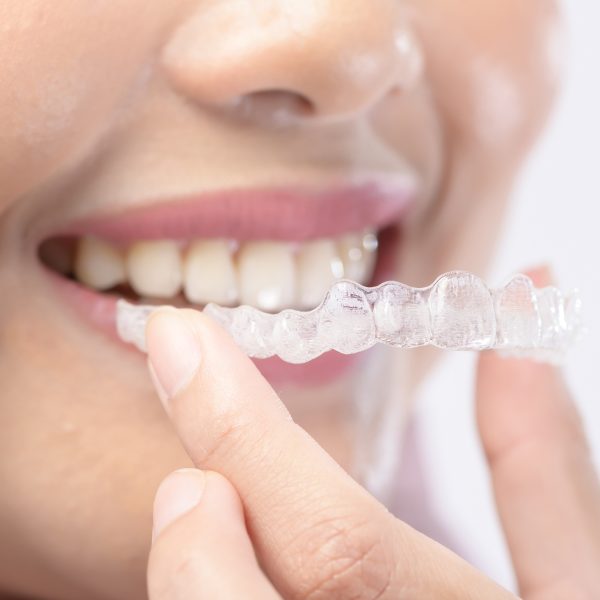What is Orthodontic Treatment?
Orthodontic treatment is about more than straightening teeth—it’s about improving function, balance, and overall confidence. Diagnosis and treatment planning is critical in orthodontics and focuses on facial balance, jaw position, as well as neuromuscular and airway considerations.
Every patient is unique and that’s why our orthodontic treatment plans are tailored for you. At your initial consultation appointment, we will take photos, xrays, and discuss your concerns in order to develop an orthodontic plan specific for you.

Early Treatment
The Canadian and American Association of Orthodontists recommend an assessment with an orthodontic specialist no later than age 7. Although treatment may not be needed at this age, orthodontists can identify emerging problems with jaw growth and crowding that can be intercepted at an early stage. Early treatment may prevent more serious problems from developing and may make treatment at a later age shorter and less complicated.
Indications for early orthodontic treatment (Phase 1) include:
- Constricted jaws
- Guide jaw growth
- Decrease risk of trauma to protruded front teeth
- Improve oral habits (thumbsucking)
- Guide permanent teeth into a more favorable position
Possible Risks & Complications
There is a risk, however small and infrequent, for complications even with the most careful sedation case. The following are some (but not necessarily all) of these possible risks and complications.
Nitrous oxygen sedation, although considered safe as it is inhaled and exhaled, does have associated risks. There is a risk of diffusion hypoxia (decreased oxygen in the body) at the end of the procedure. There is a risk of becoming unconscious and in extremely rare cases, death. The patient is given 100% oxygen for 3-5 minutes at the end of the procedure to prevent diffusion hypoxia.
Both oral and IV sedation, administered following appropriate guidelines, are considered safe in healthy individuals. There is a risk of over sedation which can cause unconsciousness and subsequent damage to internal organs including brain damage and possibly death. The patient’s vitals are continuously monitored during the procedure to prevent oversedation. In addition, at the site of the IV catheter placement, there is a minimal risk of hematoma formation (localized swelling filled with blood) which generally heals on its own.
With both oral and IV sedation there is a risk of being overly sedated when additional sedative medications are taken. It is therefore recommended that the patient not consume alcohol or any other sedative medications within 24 hours after the sedation. Sedation causes a depressed level of cognition and therefore decision making is impaired. A patient should not drive, operate machinery or undertake any activity that requires alertness. Nor should a patient undertake any positions of responsibility or make any important decisions for at least 24 hours after the procedure.
Adolescent Treatment
The early teenage years (ages 12-15) are the most common time to begin comprehensive orthodontic treatment. At this age, all permanent teeth have typically erupted and orthodontic problems can be readily diagnosed and treated.
During the adolescent years, most children are experiencing growth spurts. These growth spurts are helpful in correcting some bites, including overbites and cases where the lower jaw is further behind the upper jaw.
The teen years are also the time when the majority of their peers are going through orthodontics as well, making cooperation and compliance easier. Patient cooperation is critical for a good result with orthodontics. We find that patients with the best cooperation have the best results and finish treatment sooner.
Adult Treatment
Whether you are looking for minor revisions from teeth shifting or a smile makeover, there is no age limit to orthodontics.
Indications for orthodontic treatment in adults include:
- Improvement of overall functional and health of the teeth and bite
- Improved access for oral hygiene
- Reduce uneven wear or grinding of teeth
- Reduce/stop breakdown or loss of teeth and bone that supports the teeth
- Idealize space for future restorative dental treatment
- Improve smile esthetics and self-esteem
Types of Orthodontic Treatment
There are many orthodontic appliance options available today, with each option having their uses and benefits.
The following are the treatment options.

Braces
Braces are the most common type of appliance used in orthodontic treatment. Braces offer a tried and true method of achieving successful results in both mild and complex situations. Metal braces are durable and long-lasting, allowing us to achieve the movements we desire with great predictability and accuracy.
Advances in technology have made braces easier to maintain and much more comfortable. Modern braces are smaller and more efficient. The newest self-ligating braces allow for less friction, less discomfort and more efficient treatment, meaning less time at the orthodontist!

Clear Aligners
Clear aligners, commonly known as Invisalign, are a discreet way of straightening your teeth without using traditional braces. They are custom-made, removable, and a great esthetic option of achieving straight teeth. Clear aligners are meant to be worn 22 hours a day and gradually shift teeth into their ideal position. These removable trays are custom-made to gradually shift teeth into their ideal positions.
Advantages of Clear Aligners
- Aligners are virtually invisible
- Flexibility to eat the foods you want
- Brush and floss without wires and brackets in the way
Book your free orthodontic consultation to find out which options are best suited for you!

